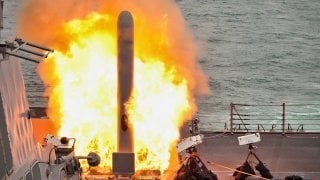The Royal Australian Navy Becomes the World's Third to Test-Fire a TLAM
"HMAS Brisbane, a Hobart class destroyer, has successfully fired a Tomahawk missile during a test and evaluation activity conducted off the west coast of the United States … In line with the priorities set out in the 2024 National Defence Strategy," the Albanese Government has said.
When one thinks of the United States Navy’s (USN) partnership with the Royal Australian Navy (RAN), the nuclear submarine construction pact known as AUKUS (as in Australia, the United Kingdom, and the United States) surely comes to mind.
However, this long-standing partnership also excels in the arena of surface warfare cooperation, and this was most recently demonstrated earlier this month when a RAN surface vessel successfully test-fired a Tomahawk Land Attack Cruise Missile (TLAM) for the first time. With this test, Australia has become only the third nation to fire this weapon (after the United States and the UK; poetically apropos in light of that aforementioned AUKUS trio).
Bottom Line Up Front
I initially learned of this momentous occasion courtesy of Iain Ballantyne, editor of Warships International Fleet Review. Naturally, being both the naval technology buff and Australophile that I am, I felt compelled to do some further digging on this topic.
On December 10, 2024, the Office of the Australian Defence Minister announced:
“HMAS Brisbane, a Hobart class destroyer, has successfully fired a Tomahawk missile during a test and evaluation activity conducted off the west coast of the United States … In line with the priorities set out in the 2024 National Defence Strategy, the Albanese Government is committed to accelerating the acquisition of long-range strike capabilities for the Australian Defence Force (ADF) … With an extended range of up to 2,500km [1,553 miles], the Tomahawk is a world-class capability, which allows maritime platforms to perform long-range precision strike against land targets. Acquiring this capability significantly enhances the ADF’s ability to deter against any potential threat and keep Australians safe.”
HMAS Brisbane (III) (Pennant No. D41) Initial History and Specifications
HMAS Brisbane (III), built by the Air Warfare Destroyer Alliance—comprised of the Defence Materiel Organisation, ASC, and Raytheon Australia—is the second of three ships of the Hobart-class guided missile destroyer (DDG) and is the third RAN warship to bear the Brisbane moniker. (The first was a World War I-era Town-class light cruiser commissioned on Halloween Day 1916 and decommissioned on September 24, 1935; the second was a Perth-class DDG commissioned on December 16, 1967, and decommissioned on October 19, 2001.
As for Brisbane (III), she was laid down on February 3, 2014; launched on December 15, 2016, by Robyn Shackleton; and commissioned on October 27, 2018. Her specifications and vital status include: a displacement of 7,000 tons; a hull length of 146.7 meters (481.2 feet); a beam width of 18.6 meters (61.0 feet); a draught of 7.2 meters (23.6 feet); a top speed of 28+ knots; a range of 4,500 nautical miles (whilst traversing at 18 knots); and a crew complement of 180+ commissioned officers and enlisted sailors.
Brisbane (III) is also heavily armed. She carries:
o One Mk45 5-inch 62 caliber main gun
o MU90 torpedoes (in 2 × 2-tube Mark 32 Mod 9 torpedo launchers)
o Two x 25mm M242 Bushmaster on Typhoon mounts
o One x Phalanx Close-In Weapons System (CIWS)
o A Mk41 Vertical Launch System (48 VLS Cells)
o RIM-66 standard 2 missiles
o A RIM-162 Evolved Sea Sparrow missile
o Advanced Harpoon via 2 x quad launchers
Brisbane’s unofficial nickname is “The Steel Cat,” and her motto is “Aim At Higher Things” (not to be confused with the longtime U.S. Air Force advertising slogan “Aim High”).
TLAM Initial History and Specifications
The BGM-109 Tomahawk Land Attack Missile (TLAM) was initially manufactured by General Dynamics, followed by McDonnell Douglas (which eventually merged into Boeing), Hughes Aircraft Corporation, and now Raytheon Missiles & Defense. The missile officially entered into operational service with the USN in 1983 but wasn’t officially “blooded” in combat until eight years later, during the Persian Gulf War.
Therein, the USN launched 288 of these deadly accurate missiles against Iraqi targets including surface vessels and submarines as part of the ultimately successful effort to end then-Iraqi strongman Saddam Hussein’s illegal occupation of Kuwait. My National Interest colleague Robert Farley adds: “Tomahawks have made an appearance in virtually every conflict that the United States has decided to associate itself with since the 1990s.”
Additional specifications and vital stats for the Tomahawk (besides the range figure cited in the quoted passage from the Australian Ministry of Defence) include:
o Mass: 2,900 lb. (1,300 kg), 3,500 lb. (1,600 kg) with booster
o Length: 18 ft 3 in (5.56 m) without booster; 20 ft 6 in (6.25 m) with booster
o Diameter: 20.4 in (0.52 m)
o Wingspan: 8 ft 9 in (2.67 m)
o Warhead (conventional, i.e., non-nuclear): 1,000 lbs. (450 kg) high explosive or submunition dispenser with BLU-97/B Combined Effects Bomb or PBXN
o Flight Altitude: 98-164 ft (30–50 m) above ground level
o Max Airspeed: Mach 0.74 (about 570 mph; 500 kn; 920 km/h)
About the Author: Christian D. Orr
Christian D. Orr is a Senior Defense Editor for National Security Journal (NSJ). He is a former Air Force Security Forces officer, Federal law enforcement officer, and private military contractor (with assignments worked in Iraq, the United Arab Emirates, Kosovo, Japan, Germany, and the Pentagon). Chris holds a B.A. in International Relations from the University of Southern California (USC) and an M.A. in Intelligence Studies (concentration in Terrorism Studies) from American Military University (AMU). He has also been published in The Daily Torch, The Journal of Intelligence and Cyber Security, and Simple Flying. Last but not least, he is a Companion of the Order of the Naval Order of the United States (NOUS).

